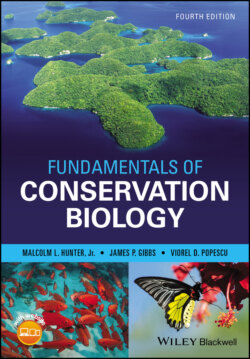Читать книгу Fundamentals of Conservation Biology - Malcolm L. Hunter Jr. - Страница 101
Evolutionary Potential
ОглавлениеA key requisite for natural selection is genetic‐based variability in the fitness of individuals; that is, some individuals must be more likely to survive and reproduce than others. If every individual were genetically identical and only chance determined which ones left progeny, then populations would change erratically through time, if at all. If they are to persist, however, populations must change as their environment changes, which environments everywhere are now doing rapidly (see Chapter 6). Of course, the physical world has always changed as continents drift around the globe, mountains rise and erode, oceanic currents and jet streams shift paths, and the planet’s orbit around the sun varies. The biological world also changes as species evolve, become extinct, and shift their geographic ranges, coming into contact with new species that may be predators, prey pathogens, or competitors. Changes have been particularly dramatic during the last few decades as human populations and their technological capabilities have grown and profoundly altered the conditions for evolution in most species. To put it more directly: humans are now the central organizing reality around which all nonhuman life will evolve. To some degree, all species must respond to the environmental changes we are wreaking almost everywhere if they are to survive. And they need genetic diversity to do so.
The potential rate of evolution is directly proportional to the amount of variability in a population, or to put it another way, species with greater genetic diversity are more likely to be able to evolve in response to a changing environment than those with less diversity. The gray squirrel situation discussed earlier (see Fig. 5.3) is a good example: if the genetic variation that generates the two color morphs of squirrels were not present 300 years ago the species may well have gone extinct rather than evolved toward the more common gray form we see today. Overharvest can also select for changes in plant morphology as long as there is genetic variation present for selective processes to operate on (Fig. 5.6). A similar story could be told for many species that have rapidly adapted to human‐caused changes in their environments (see Stockwell et al. 2003; Carroll et al. 2014).
Figure 5.6 (a) Species of snowball plants of the genus Saussurea that are used in traditional Tibetan and Chinese medicine have declined in height over the past 100 years (S. laniceps). (b) Another species that is seldom collected, S. medusa, showed no significant decline.
(Courtesy of Law and Salick/National Academy of Sciences, USA)
Environments change through space, as well as time, and a species with greater genetic diversity is more likely to colonize a wider range of environments than a species with limited genetic diversity. For example, a survey of the heterozygosity and polymorphism of 189 species of amphibians indicated that genetic diversity was greatest in amphibians that lived in the most heterogeneous environments (e.g. forests) and least in homogeneous environments (e.g. aquatic ecosystems and underground) (Nevo and Beiles 1991). A similar pattern has been shown for plants (Gray 1996). More disturbed environments also tend to support species with lower genetic diversity (Banks et al. 2013).
